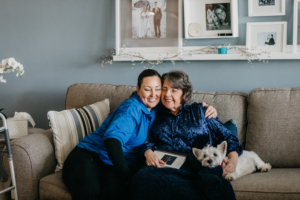If your senior loved one lives at home alone, or lives at home with a partner, they may not get regular companionship visits. Further, less socialization can leave them with an increased risk of feeling lonely. While it can be sad to think that your loved one is feeling lonesome, there is also research that demonstrates that loneliness can lead to serious negative health outcomes in the senior population. As humans, we are meant to feel connected to others and that need only increases as we age. Fortunately, companionship visits are an excellent way to provide consistent connection.
Here’s what you need to know about loneliness in older adults. Perhaps most importantly, here’s what you need to know about how companionship visits are the key to better health.
Research About Senior Loneliness
For so many years, healthy aging meant you avoided falling and the emergency room. “Successful aging” meant you were active and walked daily. It also meant you passed an annual doctor visit with flying colors. However, in the past decade, aging research is showing us that we have all been missing a huge component in wellness: socialization.
Researchers have been studying the effects of loneliness and isolation in seniors long before the COVID-19 pandemic came along to further isolate older adults. The National Institute on Aging reports that feeling lonely or disconnected from peers can lead to a litany of health problems ranging from depression and anxiety to high blood pressure and even premature death. Isolation has also been linked to rapid cognitive decline and even decreased immune response.
Companionship Visits as a Solution

The research about perceived loneliness in seniors has pointed to a solution: consistent connection from a circle of peers, including visiting caregivers. At Total Care Connections, we see our companionship visits making a real difference in the lives of those we serve. While we always build a relationship with each of our clients, based on their own personal preferences and personalities, our companionship services allow us to create a meaningful relationship with a senior who might otherwise feel lonely throughout their week.
Companionship visits look different based on each client we serve, but it’s common to find our caregivers:
- Making a pot of coffee and sharing a cup with a client
- Looking through old photo books together
- Taking a walk to find new flowers or birds
- Grabbing lunch at a favorite neighborhood spot
- Baking a favorite recipe together before a family gathering
- Singing favorite songs
- Reminiscing about favorite memories
- Creating unique art together
No matter how our caregivers are interacting with our clients, they are always focused on the client’s individual needs. We want every interaction to be a positive and supportive one.
Ready to learn more about home care services, but you aren’t quite sure where to start? Download our free resource, The Comprehensive Guide for Choosing a Home Care Agency, to build your confidence as you begin to pick the best agency for your situation.
